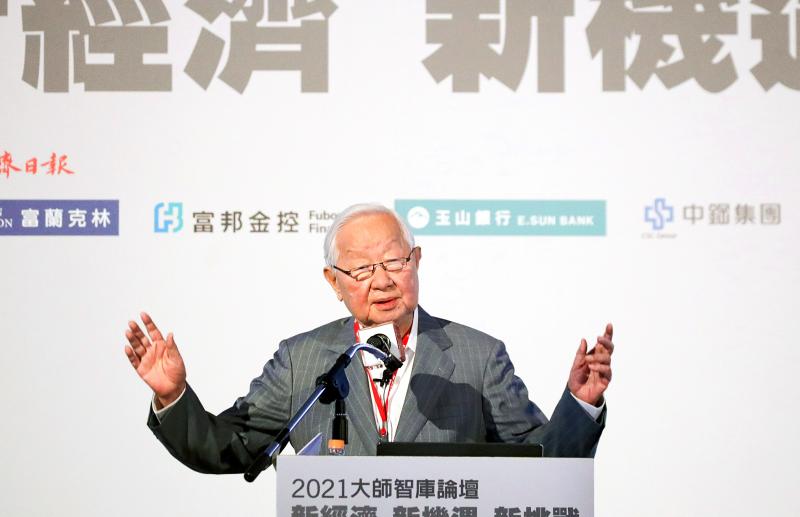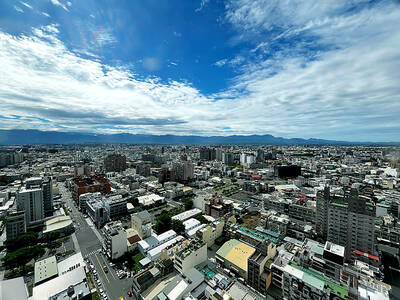Global investors are in for a treat. An extremely expensive game of one-upmanship is being played out in the semiconductor industry, where the winners will look like heroes and the rest might not even survive.
All told, more than US$700 billion has been pledged over the next decade to expand production capacity for the chips that run smartphones, power data centers and one day will drive vehicles.
Samsung Electronics Co is the latest to show its hand, reporting third-quarter numbers that put it on track to post record spending for this year and setting it up for even more next year.

Photo: I-Hwa Cheng, Bloomberg
In August, the South Korean giant said it would bring forward plans to invest US$150 billion on advanced chipmaking, joining Taiwan Semiconductor Manufacturing Co (TSMC, 台積電) Intel Corp, Micron Technology Inc and SK Hynix Inc in a massive gamble that the world’s appetite for electronics will continue unabated. By comparison, those five companies shelled out just US$70 billion in 2018.
This sudden hunger for capacity is being pinned on the recent component shortage that has crimped automobile output and driven up prices. Yet the latest data on lead times between orders and delivery indicate this crisis has already peaked.
Beyond this short-term hiccup, executives are betting that a confluence of 5G mobile communications, artificial intelligence and greater automation across industries, including transport and manufacturing, would create a sustained need for more chips.
They might be right, but that still does not justify their ridiculous spending plans.
Instead, it seems nationalism and government interference are having an outsize influence on market forces, which will result in excessive expansion that would not be matched by even the most bullish of demand scenarios.
Samsung said on Thursday that it plans to triple some capacity by 2026, which comes in the context of a bold blueprint outlined earlier this year by South Korean President Moon Jae-in aimed at keeping the nation’s place as a technology powerhouse.
Between them, Samsung and SK Hynix expect to spend about US$450 billion in the coming decade, with more than 150 other companies as part of a coordinated effort to continue the development and production of semiconductors, which the South Korean government calls a “strategic weapon.”
Intel chief executive officer Pat Gelsinger and Micron chief executive officer Sanjay Mehrotra are determined not to let the US fall behind either, and have spent much of this year lobbying Washington for handouts to fund their own expensive programs. Micron last week pledged US$150 billion on factories, and research and development over the next 10 years and made clear that it expects the US government to give grants and tax breaks to help make that happen.
Gelsinger and his team have been less subtle about their demands. The 60-year-old, who returned to helm Intel after more than a decade away, is boosting spending by 30 percent this year to US$19 billion and is likely to increase that figure threefold over the next few years as he seeks to catch up with TSMC and Samsung.
However, plans to develop a new factory on US soil “would be very difficult” without the government doling out more than US$50 billion of incentives outlined in the bipartisan CHIPS act that has yet to pass the US House of Representatives, government relations chief Al Thompson told Bloomberg News last week.
In the middle of this is global leader TSMC, which is being courted by governments around the world, but would much rather keep its factories at home. Political pressure from Washington, coupled with generous enticements, left the Hsinchu-based company with little choice but to announce a new factory in Arizona, just down the road from one of Intel’s largest operations.
However, company founder and former chairman Morris Chang (張忠謀) has not minced words on US hopes of revitalizing a sector that lends its name to Silicon Valley.
Known as the godfather of the Taiwanese chip industry, Chang has repeatedly noted that high costs, a dearth of local suppliers and comparative lack of talent put the US behind Taiwan and other nations.
Gelsinger’s argument that the industry needs to be re-shored are driven by self-interest, Chang said this week in Taipei.
The problem for Intel and those in Washington is that Chang, himself a US citizen, is not wrong. Intel fell behind in manufacturing technology, lost ground in computer processors to local rival Advanced Micro Devices Inc and was recently dumped by Apple Inc.
Gelsinger is pinning his hopes of returning the company to relevance on a brash plan to expand capacity and enter the chip foundry business dominated by TSMC and Samsung.
However, to pay for it, as Thompson noted, the company needs American taxpayer help.
Seoul also does not want to fall behind. While China is lagging in semiconductor technology, it might pose a threat in memory chips — the bread and butter of South Korea’s industry and a commodity product sold mostly on price.
An onslaught of cheap components could strike a painful, although not fatal, blow to Samsung and SK Hynix. The natural response is to boost capacity and technology to stay ahead of the game, while also allowing it to move into new areas like telecommunications and artificial intelligence.
However, even with the looming adoption of more advanced semiconductors, there would not be enough growth to cover the costs.
By my calculations, the top five semiconductor manufacturers — which between them account for half the market — are to spend close to US$150 billion on capacity expansion in 2023, almost double what they shelled out in 2019 and about 50 percent more than projections for this year.
Yet, according to trade group WSTS, global semiconductor growth is likely to climb just 10 percent next year. Data compiled by Bloomberg Intelligence suggest even more sedate numbers, with just 4 percent expansion next year and only 9 percent from next year to 2023.
We are already seeing signs that supply is outpacing demand in memory, which this year would account for 29 percent of the chip market, resulting in falling prices.
If trade groups and analysts envision only modest growth in coming years, you can be sure industry executives do, too. That means their aggressive capacity expansion is not driven by a deep belief that the market is truly going to double in just four years, as their spending suggests, but that they are in a desperate land grab hoping that size and capacity will be enough to muscle out rivals.
Chang is right that the lobbying efforts are driven by self-interest.
However, cheered on and funded by eager politicians, global semiconductor companies are accelerating toward a capacity expansion cliff. Let us see who flinches first and who plunges off the edge.
Tim Culpan is a Bloomberg Opinion columnist covering technology. He previously covered technology for Bloomberg News.
This column does not necessarily reflect the opinion of the editorial board or Bloomberg LP and its owners.

BYPASSING CHINA TARIFFS: In the first five months of this year, Foxconn sent US$4.4bn of iPhones to the US from India, compared with US$3.7bn in the whole of last year Nearly all the iPhones exported by Foxconn Technology Group (富士康科技集團) from India went to the US between March and last month, customs data showed, far above last year’s average of 50 percent and a clear sign of Apple Inc’s efforts to bypass high US tariffs imposed on China. The numbers, being reported by Reuters for the first time, show that Apple has realigned its India exports to almost exclusively serve the US market, when previously the devices were more widely distributed to nations including the Netherlands and the Czech Republic. During March to last month, Foxconn, known as Hon Hai Precision Industry

Taiwan Semiconductor Manufacturing Co (TSMC, 台積電) and the University of Tokyo (UTokyo) yesterday announced the launch of the TSMC-UTokyo Lab to promote advanced semiconductor research, education and talent development. The lab is TSMC’s first laboratory collaboration with a university outside Taiwan, the company said in a statement. The lab would leverage “the extensive knowledge, experience, and creativity” of both institutions, the company said. It is located in the Asano Section of UTokyo’s Hongo, Tokyo, campus and would be managed by UTokyo faculty, guided by directors from UTokyo and TSMC, the company said. TSMC began working with UTokyo in 2019, resulting in 21 research projects,

Meta Platforms Inc offered US$100 million bonuses to OpenAI employees in an unsuccessful bid to poach the ChatGPT maker’s talent and strengthen its own generative artificial intelligence (AI) teams, OpenAI CEO Sam Altman has said. Facebook’s parent company — a competitor of OpenAI — also offered “giant” annual salaries exceeding US$100 million to OpenAI staffers, Altman said in an interview on the Uncapped with Jack Altman podcast released on Tuesday. “It is crazy,” Sam Altman told his brother Jack in the interview. “I’m really happy that at least so far none of our best people have decided to take them

Taiwan’s property market is entering a freeze, with mortgage activity across the nation’s six largest cities plummeting in the first quarter, H&B Realty Co (住商不動產) said yesterday, citing mounting pressure on housing demand amid tighter lending rules and regulatory curbs. Mortgage applications in Taipei, New Taipei City, Taoyuan, Taichung, Tainan and Kaohsiung totaled 28,078 from January to March, a sharp 36.3 percent decline from 44,082 in the same period last year, the nation’s largest real-estate brokerage by franchise said, citing data from the Joint Credit Information Center (JCIC, 聯徵中心). “The simultaneous decline across all six cities reflects just how drastically the market